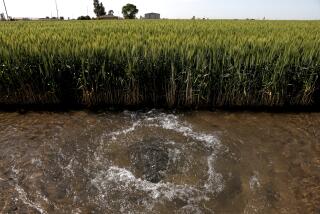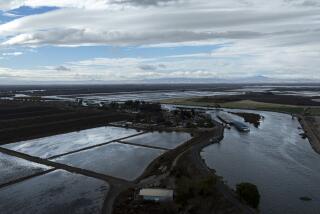Bush Offers New Wetlands Policy; Critics Assail It
KENNEBUNKPORT, Me. — Coming face to face with the economic reality of his campaign pledge that there would be “no net loss” in the nation’s protected wetlands, President Bush Friday announced a new plan for the environmentally sensitive lands that he said is intended to balance ecological concerns with economic demands.
“The plan seeks to balance two important objectives--the protection, restoration and creation of wetlands and the need for sustained economic growth and development,” the President said in a written statement distributed while he spent a cloudy day at his seaside vacation compound here.
The measures announced by the White House would authorize the purchase of as much as 1 million acres of wetlands under last year’s farm bill, expand research and restore some wetlands on federal property.
But they would sharply revise the definition of what constitutes a wetland, leading to what critics allege would be the opening of millions of acres to development, from the Alaska tundra to the Florida Everglades. The measures would also speed up the process under which permits are granted for such development.
Wetlands specialists at the National Wildlife Federation predicted that the new regulations--complicated rules covering the extent of soil saturation and vegetation--would expose to development 10 million to 40 million of the 100 million existing acres of American wetlands. Even under strict rules promulgated at the end of the Ronald Reagan Administration, the nation has been losing 290,000 acres of wetlands each year through natural and human actions.
Areas considered wetlands can be anything from a depression on the prairie that fills with floodwater in rainy seasons--seemingly little more than a muddy pothole, to be sure, but so crucial that half of America’s waterfowl breed in them--to the always-drenched tidal marshes along the Atlantic Coast.
Under the existing regulations, huge swaths of land--half of Vermont, 40% of Maryland’s Eastern Shore and much of suburban Houston, for example--could be considered wetlands.
“Wetlands serve an important role in flood control,” Bush said. “They help filter wastes from water. They provide an important habitat and breeding ground for fish, birds and animals. And they are an important recreational resource.”
The action Friday amounted to a first, but not necessarily final, step. Before taking effect, the Bush plan is subject to revision after a 60-day comment period. In any case, the real battle is likely to be fought in Congress, where a bill is under consideration.
The new policy was denounced by several environmental groups.
The National Wildlife Federation said that it means the Bush Administration has “officially turned its back” on the promise of “no net loss” of wetlands.
The policy “represents a death sentence for millions of acres of this critical American resource,” said Jay D. Hair, the federation president.
The group criticized plans to have a newly created federal panel classify wetlands’ value. Such ranking “should be based on scientific criteria,” Hair said, and not be turned into a “political exercise.”
The federation noted that the new rules do away with regulations that have permitted the development of wetlands only if there is no practical alternative. Under the new rules, landowners would only be blocked from developing wetlands deemed to be of “high value.”
Brooks Yeager, spokesman for the National Audubon Society, said that the policy will continue to protect lakes but will open to development such environmentally important areas as so-called prairie potholes and bottom-land hardwood areas that are flooded only for weeks or months a year.
Both areas are used for nesting and roosting by many species of ducks. Bottom-land hardwood areas, which are near river beds, are also necessary for growth of plants and small animals that feed river-area food chains.
When campaigning for the presidency in 1988, Bush promised that there would be “no net loss” of the total area of the wetlands during a Bush Administration. “All existing wetlands, no matter how small, should be preserved,” he declared during the campaign.
Ten days before he took office, a team of government scientists prepared a 100-page list, used by the Army Corps of Engineers--the chief agency granting development permits--that sets out the factors that define a wetland.
The list doubled the amount of land under wetlands protection at the time, said Deputy White House Press Secretary Gary Foster. It also prompted “floods of complaints” from landowners, who were limited in the use to which they could put their property, and from members of Congress, he said.
The new definitions, Foster said, are “not as extreme, obviously,” as those issued at the end of the Reagan Administration in January, 1989.
White House Press Secretary Marlin Fitzwater argued that Bush’s new definitions are not intended to simply revise federal regulations so that millions of acres of wetlands can be opened for development.
“He’s defining wetlands in a common-sense way that preserves the nation’s wetlands but makes good sense,” the White House spokesman said. “We simply want a common-sense definition that is realistic and that does indeed protect wetlands.”
But he acknowledged that the plan is likely to draw complaints, saying: “If you’re from the school that says every mud puddle is a wetland, I don’t think that makes common sense, and I think the American people clearly recognize that.”
When asked if the policy means the end of Bush’s adherence to the “no net loss” pledge, Fitzwater said: “He wants to protect wetlands. And ‘no net loss’ is still our policy.”
According to the White House, three-quarters of the nation’s wetlands are in the private hands of coastal developers, individual farmers and large landholders. Among areas on which the wetlands decisions could have an impact are Chicago and Denver, where efforts to expand airports or build new ones could be set back by limits imposed on use of land.
Gov. Pete Wilson’s office in Sacramento said that it is awaiting details of the plan before it comments. “We are hopeful to get a good, pro-active wetlands proposal out of the Bush Administration,” Deputy Press Secretary James Lee said. “We don’t know if the proposal they have issued leads us in that direction.”
Wetlands have been under pressure from growth and development along the state’s 1,000-mile-long coast. Most recently, the Walt Disney Co. has proposed filling in 250 acres of land along the Long Beach shoreline to build a $3-billion amusement park.
It was unclear Friday what impact the federal proposal would have on California’s coastal wetlands. Development permits are required by both the California Coastal Commission, which operates under its own wetlands rules, and the Army Corps of Engineers.
“We generally require the restoration or mitigation of any wetlands losses,” commission spokesman Jack Liebster said.
The President’s decisions amounted to a setback for William K. Reilly, the administrator of the Environmental Protection Agency, who, in his previous post as president of the Conservation Foundation, had developed an expertise on the issue and helped the Bush campaign come up with the “no net loss” policy.
He was said to have pressed for more comprehensive definitions but came head to head with, among others, Budget Director Richard G. Darman and White House Chief of Staff John H. Sununu, and in the end was unable to prevail.
In a lukewarm endorsement of the decision, Reilly said in a written statement made available by the White House that “in the final analysis it will be necessary to restore or create wetlands if the nation is to achieve ‘no net loss.’ ”
“The policy reforms announced today involve a series of practical measures to do that, to improve the vitally important science needed for effective wetland protection and to ensure mitigation for any wetland losses that do occur,” he said.
Staff writers Paul Richter in Washington and Larry B. Stammer in Los Angeles contributed to this story.
More to Read
Sign up for Essential California
The most important California stories and recommendations in your inbox every morning.
You may occasionally receive promotional content from the Los Angeles Times.









